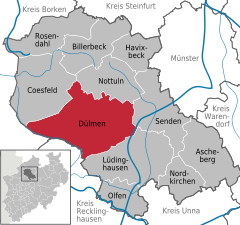Dülmen
| Dülmen | ||
|---|---|---|
 | ||
| ||
 Dülmen | ||
Location of Dülmen within Coesfeld district 
 | ||
| Coordinates: 51°49′51″N 7°16′42″E / 51.83083°N 7.27833°ECoordinates: 51°49′51″N 7°16′42″E / 51.83083°N 7.27833°E | ||
| Country | Germany | |
| State | North Rhine-Westphalia | |
| Admin. region | Münster | |
| District | Coesfeld | |
| Subdivisions | 7 | |
| Government | ||
| • Mayor | Elisabeth Stremlau (SPD) | |
| Area | ||
| • Total | 184.49 km2 (71.23 sq mi) | |
| Elevation | 46 - 150 m (−446 ft) | |
| Population (2012-12-31)[1] | ||
| • Total | 46,071 | |
| • Density | 250/km2 (650/sq mi) | |
| Time zone | CET/CEST (UTC+1/+2) | |
| Postal codes | 48249 | |
| Dialling codes | 02594 (some districts differ) | |
| Vehicle registration | COE | |
| Website | www.duelmen.de | |
Dülmen is a municipality in the district of Coesfeld, North Rhine-Westphalia, Germany.
Geography
Dülmen is situated in the south part of the Münsterland area, between the Lippe river to the south, the Baumberge hills to the north and the Ems river to the east. South of Dülmen the Ruhr area is located.
Neighbouring municipalities
Divisions
After the local government reforms of 1975 Dülmen consists of the 7 subdivisions Dülmen, Kirchspiel, Buldern, Hausdülmen, Hiddingsel, Merfeld and Rorup.
Merfeld was first mentioned in 890. It became a part of Dülmen in 1975. It is known for its herd of Dülmen Ponies. Rorup was first mentioned in 1050 and became a district of Dülmen in 1975.
History
The place was first mentioned as Dulmenni in 889, as a property of Werden Abbey. Dülmen received town privileges in 1311. It joined the Hanseatic League in 140. It was part of the Prince-Bishopric of Münster until it was mediatised in 1803. After a short period in the hands of the House of Croÿ, it was taken by the French in 1811. After the defeat of Napoleon, it became part of the Prussian Province of Westphalia. The Dülmen oil plant was a target of the Oil Campaign of World War II: 90% of the city was destroyed[citation needed] and the city was rebuilt after the war. In 1973, the population reached 20,000. In 1975, Rorup, Merfeld, Hiddingsel, Buldern, Hausdülmen and Kirchspiel Dülmen became part of Dülmen.

International relations
Dülmen is twinned with:
Transportation
Dülmen can accessed by the A43. Dülmen station is on the Essen–Wanne Eickel–Münster line, which was built by the Cologne-Minden Railway Company, and the Dortmund–Enschede railway, which was built by the Dortmund-Gronau-Enschede Railway Company and links Dortmund and Gronau. The nearest airports are the Münster-Osnabrück Airport in Greven and the Düsseldorf International Airport.
Notable persons
- Bl. Anna Katharina Emmerick
- Franka Potente, actress
- Jürgen Drews, entertainer
- Hartmut Surmann, robotics researcher
- Clemens Brentano, writer, lived in Dülmen from 1819 to 1824
- Franz von Papen, politician, lived in Dülmen from 1918 to 1930
References
- ↑ "Amtliche Bevölkerungszahlen". Landesbetrieb Information und Technik NRW (in German). 31 July 2013.
External links
- Official site (German)
- Sommer in Dülmen (German)
- Winter in Dülmen (German)
- Heimatverein Dülmen e.V. (German)
- Local radiostation (German)
- Local merchant community (German)
| Wikimedia Commons has media related to Dülmen. |
| |||||||
